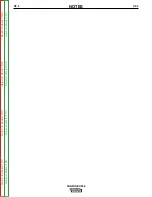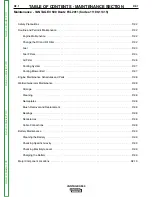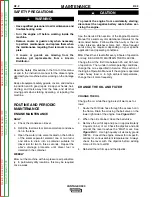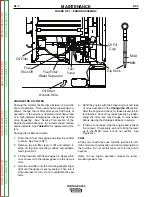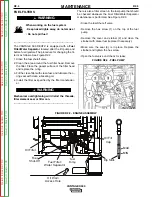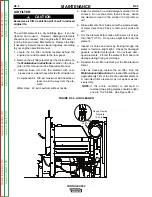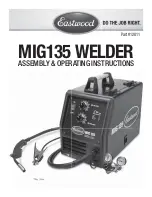
INSTALLATION
A3.4
A3.4
VANTAGE® 500
LIFTING
The Vantage lift bale should be used to lift the machine.
The Vantage is shipped with the lift bale retracted.
Before attempting to lift the Vantage, secure the lift bale
in a raised position. Secure the lift bale as follows:
a. Open the engine compartment door.
b. Locate the two access holes on the upper mid-
dle region of the compartment wall just below
the lift bale.
c.
Use the lifting strap to raise the lift bale to the
full upright position. This will align the mounting
holes on the lift bale with the access holes.
d. Secure the lift bale with 2 thread forming
screws. The screws are provided in the loose
parts bag shipped with the machine.
FALLING EQUIPMENT can cause injury.
• Do not lift this machine using lift bale
if it is equipped with a heavy accesso-
ry such as a trailer or gas cylinder.
• Lift only with equipment of adequate
lifting capacity.
• Be sure machine is stable when lift-
ing.
HIGH ALTITUDE OPERATION
At higher altitude, output derating may be necessary.
For maximum rating, derate the welder output 5% for
every 300 meters (984 ft.) above 1500 meters (4920
ft.). For output of 500A and below, derate the welder
output 5% for every 300 meters (984 ft.) above 2100
meters (6888 ft.)
Contact a Deutz Service Representative for any engine
adjustments that may be required.
HIGH TEMPERATURE OPERATION
At temperatures above 40°C (104°F), output voltage
derating may be necessary. For maximum output cur-
rent ratings, derate the welder voltage rating two volts
for every 10°C (21°F) above 40°C (104°F).
TOWING
The recommended trailer for use with this equipment
for road, in-plant and yard towing by a vehicle
1
is
Lincoln’s K2636-1. If the user adapts a non-Lincoln
trailer, he must assume responsibility that the method
of attachment and usage does not result in a safety
hazard nor damage the welding equipment. Some of
the factors to be considered are as follows:
1. Design capacity of the trailer vs. weight of the
Lincoln equipment and likely additional attach-
ments.
2. Proper support of, and attachment to, the base of
the welding equipment so that there will be no
undue stress to the trailer’s framework.
3. Proper placement of the equipment on the trailer to
insure stability side to side and front to back when
being moved and when standing by itself.
4. Typical conditions of use, such as travel speed,
roughness of surface on which the trailer will be
operated, and environmental conditions.
5. Proper preventative maintenance of the trailer.
6. Conformance with federal, state and local laws.
1
1
Consult applicable federal, state and local laws
regarding specific requirements for use on public high-
ways.
VEHICLE MOUNTING
Improperly mounted concentrated loads may
cause unstable vehicle handling and tires or other
components to fail.
• Only transport this Equipment on serviceable
vehicles which are rated and designed for such
loads.
• Distribute, balance and secure loads so vehicle
is stable under conditions of use.
• Do not exceed maximum rated loads for compo-
nents such as suspension, axles and tires.
• Mount equipment base to metal bed or frame of
vehicle.
• Follow vehicle manufacturer’s instructions.
WARNING
WARNING
Return
to
Section
T
OC
Return
to
Section
T
OC
Return
to
Section
T
OC
Return
to
Section
T
OC
Return
to
Master
T
OC
Return
to
Master
T
OC
Return
to
Master
T
OC
Return
to
Master
T
OC

